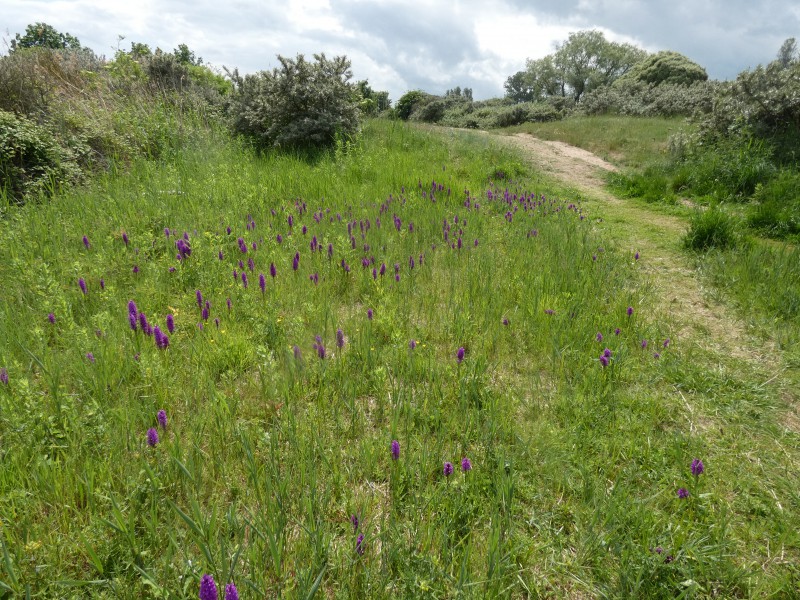By regularly coppicing areas of scrub, conservationists will dramatically improve these coastal
habitats for rare wildlife.
Coastal sand dunes are the most threatened habitat type in Europe from biodiversity loss.
At Cleethorpes, large areas of the dune grassland are becoming overgrown with scrub and rank vegetation, which reduces the size and types of habitat available for rare sand dune wildlife.
For these special sand dune species to have a future here, some areas of vegetation including patches of dense sea buckthorn need removing.
In December 2021, North East Lincolnshire Council will be cutting down carefully selected sections of scrub at Cleethorpes, working with Natural England as part of a project called Dynamic Dunescapes.
This project is working to rejuvenate coastal sand dune habitats in England and Wales, funded by National Lottery Heritage Fund and EU LIFE Programme. This work is planned in partnership with another local Dynamic Dunescapes partner organisation, Lincolnshire Wildlife Trust.
It’s a method that the dunes at Cleethorpes are familiar with. For the past 25 years, Cleethorpes Dunes have been the focus of coppicing and removal work at five-year intervals. By regularly coppicing and clearing some areas of sea buckthorn and scrub, diversity is introduced back into the habitat.
The result is a range of age, height, and plant structure within the habitat, with overgrown grassland once again exposed, and new growth flourishing. Not all scrub is removed; areas of woody growth are chosen to remain, to continue to support some of the birdlife that the Lincolnshire coast is home to. All of this leads to increases in biodiversity and the abundance of species seen.
Guy Mason, Natural England, Dynamic Dunescapes Lead Advisor, says:
“Rotational Coppicing involves us removing scrub at different places, over many years. By helping to keep the habitat diverse, we safeguard a future for the wildlife that depends on it.
The last round of scrub removal took place in 2014, and since then we have seen a range of orchids, including Southern Marsh, Common spotted, Bee, and Pyramidal orchids, start to grow in the coppiced area. This is great news for biodiversity, and especially for our local pollinators.”
Coppicing is a conservation technique that has been used for centuries. When left unmanaged, areas of hedgerow or scrub will outcompete other species and grow together to form uniform and dense blocks of vegetation, with little diversity.
By removing some areas of scrub, the ground and grassland habitats beneath are once again exposed to light and the many plants which are food for butterflies, bats, small mammals, and birds can flourish.
Creating a diversity in the ages of plants growing at Cleethorpes will allow conservationists to ensure that there are sufficient areas of the different habitats needed for each stage of the life cycles of the many birds and invertebrates.
Tish Cookson, Dynamic Dunescapes Engagement Officer at Lincolnshire Wildlife Trust has been leading public engagement for the work and is excited to see this part of the project get underway:
“It’s fantastic to see this important habitat managed in a way that has the best outcome for biodiversity, using techniques that are grounded in science, informed by evidence, and specific to the wildlife found here.”
Rachel Graham, Ecology Manager at North East Lincolnshire Council, says:
“The sand dunes are an integral part of the Humber Estuary SSSI and our Local Nature Reserve, and we’re so lucky to be able to enjoy the main pleasure beach and, with one step, enter into this gem of a habitat, one of the best coastal wildflower areas on the coast, and that’s because of the previous management of buckthorn, one of the Humber Estuary SAC features.”
Work will take place just south of the Leisure Centre to the Cafe and opposite the boating lake and is scheduled to take three weeks to complete. The public are asked to keep an appropriate distance from the workers on site and to keep dogs on short leads.
In October, a free public presentation and discussion was held online, in which the public heard from representatives from Natural England, Lincolnshire Wildlife Trust and North East Lincolnshire Council. A recording of this session is available online at https://www.youtube.com/watch?v=_vctcWOs0bE
Article and image from NELC.

About the author